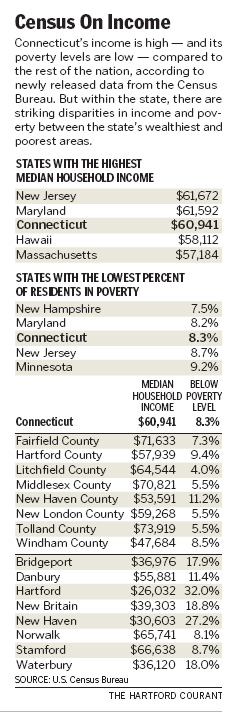 |
 |
|||
|
||||
| Web Sites, Documents and Articles >> Hartford Courant News Articles > | ||
|
State Third In Median Income Poverty Rate Below National Average August 30, 2006 WASHINGTON -- Connecticut households enjoy the third highest median income in the country, according to the latest data from the U.S. Census Bureau. The state's median income of $60,941 was more than 30 percent higher than the national figure. Only New Jersey and Maryland households recorded higher numbers. The Census Bureau surveyed 100,000 households in the spring about their incomes and health insurance in 2005. The state's median income - the number at which there is an equal number of households earning below as above - fell 3.6 percent from $63,226 in 1999. The poverty rate increased slightly, from 7.9 percent in 2000. The bureau's survey showed significant gaps between the state's wealthiest and poorest areas. Median household income in Tolland County, for example, was nearly $74,000, while in neighboring Windham County, the figure was less than $48,000. Among large cities, Stamford's median household income of nearly $67,000 was more than 2½ times the figure in Hartford, where median household income was about $26,000. Disparities in poverty were even more striking. In the city of Hartford, 32 percent of residents live in poverty - nearly four times the state average - while in New Haven, 27 percent of residents are in poverty. In Litchfield County, by contrast, 4 percent of residents live in poverty - less than half the state average. The survey also looked at health insurance coverage over two-year periods. For 2004-2005, the survey estimated an average of 11.3 percent of state residents were without insurance, up from 10.8 percent for 2003-2004. But the figure was still significantly below the national average of 15.7 percent. Nationwide, household incomes edged up slightly in 2005, but 37 million people were still living below the poverty line, about the same as the year before, the Census Bureau reported. It was the first year without an increase in poverty since 2000, just before President Bush took office. The numbers immediately became political fodder, with a little more than two months to go before midterm congressional elections that will determine whether Republicans continue to control the House and the Senate. Some Republicans blamed the stubborn poverty numbers on immigrants holding down wages. Democrats blamed the Bush administration, noting that incomes are lower and the poverty rate is higher than when Bush took office. Democrats also noted that the number of people without health insurance climbed for the sixth straight year, reaching 46.6 million people in 2005. "I know what they say about putting lipstick on a pig, but I don't see how the Bush administration can spin these numbers in their favor," said Rep. Charles Rangel, D-N.Y. Bush's budget chief said the new numbers show the economy's resilience following terrorist attacks in 2001 and Hurricane Katrina a year ago. "Unemployment is low, wages are rising and there are more jobs in America today than at any other time in history," said Rob Portman, Bush's budget director. "While we still have challenges ahead, our ability to bounce back is a testament to the strong work ethic of the American people, the resiliency of our economy, and pro-growth economic policies, including tax relief." The median household income was $46,326, a slight increase from 2004, but still below the peak of $47,671 in 1999. Mississippi, which had the lowest median income at $32,938, had the highest poverty rate, at 21.3 percent. New Hampshire had the lowest, at 7.5 percent. "For the first time on record, poverty was higher in the fourth year of an economic recovery than when the recession hit bottom," said Robert Greenstein, executive director of the Center on Budget and Policy Priorities, a Washington research group. "These disappointing figures on median income and poverty are the latest evidence that the economic growth of the past few years has had an unusually limited reach," Greenstein said. "Many middle- and low-income families are not sharing in the gains." The survey covered four months following Hurricane Katrina, which struck a year ago Tuesday. But the storm had little effect on the numbers because the survey covered incomes and health insurance for the entire year and the entire country, said David Johnson, the Census Bureau's chief of housing and household economic statistics. The official poverty level is used to decide eligibility for federal health, housing, nutrition and child-care benefits.
|
||
| Last update:
September 25, 2012 |
|
||
|

